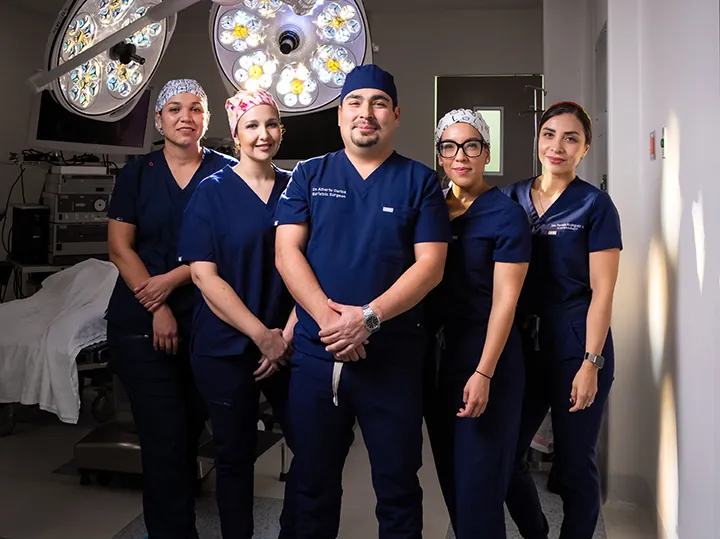Top Board Certified Gastric Bypass Specialists in Tijuana, Mexico
Our Service Includes:
-
Hospitalization
(2 nights) - Specialist Fee
- Anesthesiologist Fee
- Ground Transportation
- Hotel
- One Year Post Operative Support
- Nutrition Plan
What is a Gastric Bypass?
Gastric Bypass (Roux-en-Y) is a type of hypoabsorptive bariatric surgery. A small stomach pouch is created at the upper part of the stomach, and then the surgeon creates a bypass for food.
The bypass allows food to skip the excluded stomach and the first part of the small intestine limiting the absorption of calories. Weight Loss is achieved by absorbing less of the food.
Gastric Bypass is often used as a method to treat morbid obesity, type 2 diabetes, high blood pressure, sleep apnea, other comorbidities or a previous failed weight loss surgery.
Testimonials
Real-life stories of transformative weight loss and improved health thanks to the Gastric Bypass procedure.
Gastric Bypass Benefits
Gastric Bypass surgery is one of the most effective Weight Loss Surgerie (averaging 70-80% excess weight loss ) within the first two years. It is the Gold Standard in bariatric surgery. Among it’s benefits you can consider:
You will not be able to eat large portions of food
After Gastric Bypass Surgery patients improve from diabetes
Less calories from food are absorbed
Operation Information
n choosing Gastric Sleeve, you’re opting for a proven and versatile solution that not only addresses weight loss but positively impacts various aspects of your overall well-being. Our team at My New Body Obesity Center is dedicated to guiding you through this transformative journey with expertise, compassion, and a commitment to your long-term health.
Duration:
1.5 - 2 hours
Hospitalization:
2 days
Recovery Period:
2 weeks
(And may vary depending on the activity that the patients perform)
Our Team
Board-Certified Bariatric Specialists
At My New Body Obesity Center, we combine safety, affordability, and advanced medical innovation to assist patients worldwide in achieving healthier lives.


Am I eligible for a Gastric Bypass Surgery?
The first step to determine if you are a good candidate for a Gastric Bypass is getting in touch with one of our patients coordinators to fill a quick Health Questionnaire. Within 24 hours after receiving your information, one of our bariatric surgeons reviews your case and determines if you are a good candidate for Gastric Bypass Surgery.
To be considered a good candidate for any gastric bypass surgery most patients will need to meet the following requirements:
- Be between the agea of 18 and 65.
- Need to have realistic expectations regarding the result of the surgery.
- Need a BMI of more than 30 or with comorbidities.
Frequently Asked Questions (FAQs)
It refers to the ‘Y’ shape of the small bowel connection. During the operation, the small bowel is cut and then reconnected at one end to the newly created pouch (the new stomach) where it will now receive food that has been chewed and swallowed. None of the bowel is removed during the surgery. The new connection between the stomach pouch and the small bowel is called an anastomosis. This narrow opening helps restrict the passage of food moving from the pouch into this piece of small bowel, called the Roux limb (after a French surgeon, Roux). The Roux limb is the right arm of the “Y.” The left arm of the “Y” is the part of the bowel still connected to the excluded stomach. It carries the acids produced in the remnant stomach, the digestive juices produced by the liver and pancreas, including insulin, and some juices produced by the small bowel itself. The two arms of the “Y” are connected again.
Most patients stay two after laparoscopic gastric bypass.
You are expected to lose a percentage of your excess weight, but only a few patients lose 100% of their excess weight and reach a number established on a weight chart, most of which have been developed by an Actuary (a statistics specialist) employed by a life insurance company. That ideal weight might have little to do with your best weight, where you feel and function at peak health. When you have been carrying excess weight for a long time, your bone frame and muscle mass will have needed to increase, too, in order to support your excess weight. The standard weight charts do not reflect this. Most patients lose 60-70% of their excess weight in the first year after surgery.
References
English, W. J., DeMaria, E. J., Hutter, M. M., Kothari, S. N., Mattar, S. G., Brethauer, S. A., & Morton, J. M. (2020). American Society for Metabolic and Bariatric Surgery 2018 estimate of metabolic and bariatric procedures performed in the United States. Surgery for obesity and related diseases, 16(4), 457-463.
Dobrescu, A., Copaescu, C., Zmeu, B., Duta, C., Bedreag, O. H., Stoica, L., … & Lazar, F. (2020). Ghrelin levels and hunger sensation after laparoscopic sleeve gastrectomy compared with laparoscopic greater curvature plication in obese patients. Clin. Lab, 66, 847-853.
Reviewed by Dr. Monica Valencia,mD

Ave. Diego Rivera 2386
ZonaRío, Tijuana
Call Us Now
+1 (520) 390-4105